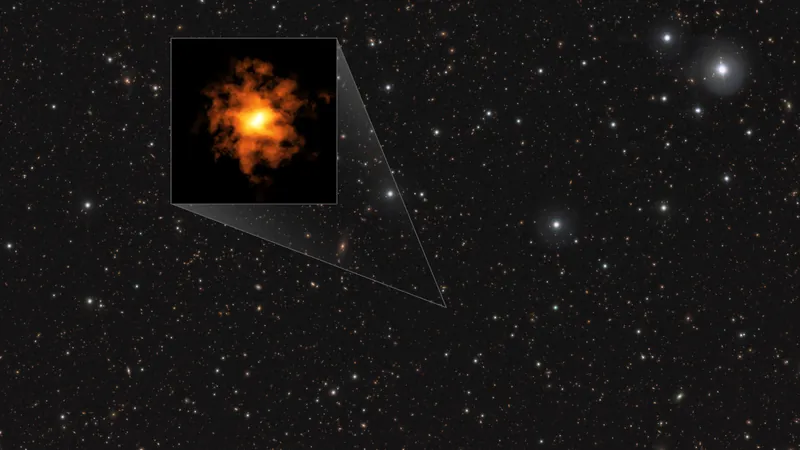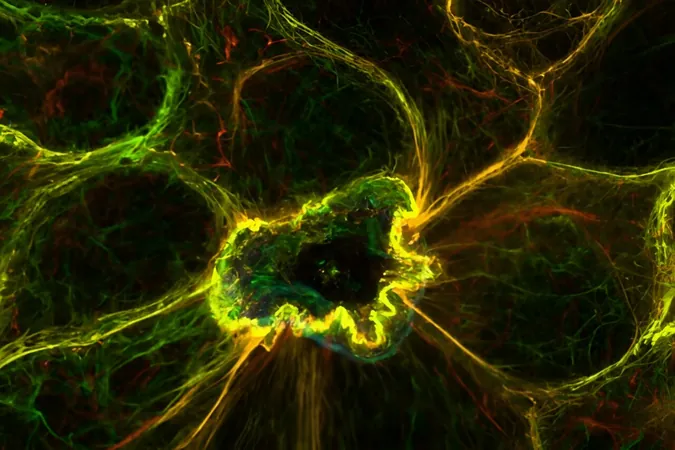
Groundbreaking Discovery: The Most Distant Spinning Galaxy Could Rewrite Cosmic History!
2024-10-08
Author: Sarah
Groundbreaking Discovery: The Most Distant Spinning Galaxy Could Rewrite Cosmic History!
Astronomers have made a stunning discovery that could upend our understanding of galactic evolution. A distant rotating disk galaxy, known as REBELS-25, has been observed at an incredible 700 million years after the Big Bang—far earlier than previously thought possible for galaxies to possess such organized structures.
Typically, scientists expect galaxies from this epoch to be small, clumpy, and chaotic. However, REBELS-25 has emerged as a "rebel" by displaying a surprising degree of order, featuring hints of spiral arms reminiscent of mature galaxies, including our own Milky Way.
This extraordinary galaxy was discovered using the Atacama Large Millimeter/submillimeter Array (ALMA), a sophisticated network of 66 radio telescopes located in the Atacama Desert of Northern Chile. Team member Jacqueline Hodge from Leiden University noted, "Our expectations surrounding early galaxies were based on the notion that they would be small and messy. The organization seen in REBELS-25 challenges that belief."
The implications of this discovery are immense. The Milky Way has developed its distinctive shape—a majestic spiral—over billions of years through mergers and collisions with other galaxies. REBELS-25's early emergence raises questions about the timeline of cosmic evolution and suggests that some galaxies may have developed their features much more rapidly than previously believed.
Lucie Rowland, the study’s lead author from Leiden University, expressed astonishment at the similarities between REBELS-25 and modern galaxies: “This galaxy’s strong rotation challenges our understanding of how quickly early galaxies transition into the orderly forms we see today.”
Initially, the team found REBELS-25 intriguing due to its indications of rotation, but it took high-resolution observations to confidently conclude its status as the most distant and strongly rotating galaxy recorded to date. This level of precision allowed astronomers to observe gas movements within the galaxy, demonstrating both toward and away motion—phenomena known as blueshift and redshift. These movements signify that the galaxy is a record-breaker, bringing new insights into the dynamics of early cosmic structures.
But that's not all. Early investigations hint that REBELS-25 may also boast an elongated "central bar" of stars potentially accompanied by spiral arms. If confirmed, this would make it the most distant spiral galaxy observed, surpassing the record previously held by cheers-2112, which was identified by the James Webb Space Telescope when the universe was around 2.1 billion years old.
Renske Smit from Liverpool John Moores University emphasized the uniqueness of this discovery, highlighting that "ALMA is the only telescope capable of such sensitive observations of distant galaxies."
As scientists continue to delve deeper into the mysteries of REBELS-25, they anticipate that further findings could reveal even more evolved structures and characteristics—transforming our grasp of galaxy formation in the early universe. The research has been accepted for publication in the Monthly Notices of the Royal Astronomical Society, and the world awaits what other secrets this cosmic "rebel" might reveal!





 Brasil (PT)
Brasil (PT)
 Canada (EN)
Canada (EN)
 Chile (ES)
Chile (ES)
 España (ES)
España (ES)
 France (FR)
France (FR)
 Hong Kong (EN)
Hong Kong (EN)
 Italia (IT)
Italia (IT)
 日本 (JA)
日本 (JA)
 Magyarország (HU)
Magyarország (HU)
 Norge (NO)
Norge (NO)
 Polska (PL)
Polska (PL)
 Schweiz (DE)
Schweiz (DE)
 Singapore (EN)
Singapore (EN)
 Sverige (SV)
Sverige (SV)
 Suomi (FI)
Suomi (FI)
 Türkiye (TR)
Türkiye (TR)